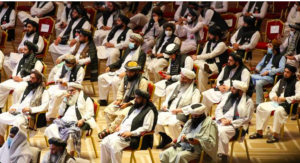
A video showing the presence of Taliban leaders in Pakistan has spread like wildfire. Afghanistan has warned Pakistan not to allow Afghan insurgents to operate from its territory. It, however, is proof of Pakistan’s double-dealing in Afghan affairs and the main cause of elusive peace in Afghanistan.
The current war in Afghanistan had its origin in wake of al-Qaeda’s 9/11 attack and the refusal of the Taliban government to surrender the terrorist leader Osama bin Laden, who was the prime suspect, to the United States in 2001, leading to the US military intervention in Afghanistan in retaliation. As the war-ravaged, efforts were made intermittently to resolve the intractable war. Successive American Presidents, George Bush, Barack Obama, and most recently Donald Trump, have tried to find a way out for the US soldiers to return home.
Conflict Resolution Attempts:
On February 27, 2018, following an expansion in brutality, Afghan President, Ashraf Ghani, proposed an unconditional conversation for peace with the Taliban, offering them acknowledgement as a lawful ideological group and the arrival of the Taliban detainees. It fell on deaf ears.
Recently, the Taliban leaders in their conversation with the US officials advised them that the Afghan issue could not be solved militarily and hence America should focus on a “peaceful strategy for Afghanistan instead of war.” But the US knew that the Taliban had in a way demonstrated their resilience and the powerful American and NATO forces had not succeeded in their war efforts.
About a month later, a gathering of 20 nations in Tashkent, Uzbekistan, endorsed the Afghan government’s “tranquillity offer” to the Taliban. The fact remains that the Taliban didn’t even react to President Ghani’s offer. The victors in a conflict do not easily accept the olive branch offered by the losing party.
While numerous initiatives had been taken by the United States, the war in Afghanistan persisted. The American people appeared to have developed an allergy to US military involvement in Afghanistan and the huge expenditure incurred there by the government. The Afghan people also had become tired of the unceasing conflicts, violence, and deaths in the country. More recently, a peace movement emerged in Afghanistan during 2018, especially following a peace march which the Afghan media referred to as the “Helmand Peace Convoy”. The peace march was a response to the bombing of a car that took the lives of 14 people. The peace marchers walked a few hundred miles from Lashkar Gah in Helmand Province, through Taliban-captured area, to Kabul. There, they met President Ghani and held a demonstration outside the United Nations Assistance Mission in Afghanistan and near foreign embassies.
1The peace march seemed to have some impact on the warring parties in Afghanistan. The Afghan government and the Taliban leaders agreed to observe a truce during the Eid al-Fitr festivities in June 2018. During the Eid truce, according to reports, the Taliban representatives went to the country’s capital and interacted with common people as well as security forces.
It was a very satisfying development for the masses of people who had lost their near and dear ones and lived in an atmosphere of intimidation and fear day in and day out. But unfortunately, the truce was short-lived. Once the Eid festivities were over and the truce period finished on 18 June of that year, fighting resumed- rockets were fired, bombs exploded and gunshots returned.
The Taliban never recognized the Afghan government as legitimate. They agreed to a temporary truce only to convey to the people that they respect all Islamic traditions and conventions. However, they were always ready to talk to the Americans, because it was the United States, according to them, that is running the government with the help of Afghan puppets.
American authorities quietly held meetings with the Taliban representatives in July 2018 at the Taliban’s political office in Doha, Qatar. President Trump had the goal of ending the war in Afghanistan from his campaign days. Encouraged by the outcome of the July meeting between the representatives of the US government and the Taliban, in September 2018 he appointed Zalmay Khalilzad as a special consultant on Afghanistan in the US State Department. Khalilzad was assigned the mission of encouraging an intra-Afghan political dialogue. It was a difficult task because the Taliban had always refused to talk with the Afghan government.
In the meantime, Russian leader Vladimir Putin sought to play a role in resolving the Afghan conflict.
He tried to facilitate a peace talk in November 2018 between the Taliban and authorities from Afghanistan’s High Peace Council. The Taliban participated in the meeting held at lodging in Moscow in February 2019. But, significantly, the Afghan government representatives were not invited to this meeting.
The quiet diplomacy and reported meetings between the US and the Taliban representatives, however, continued and, finally, an agreement reached between them in Doha in February 2020. The Taliban committed itself to stop violence, exchange prisoners, and negotiate with the Afghan Government for establishing a broad-based government. And the US agreed to end its military presence in fourteen months–May 2021.
Uncertain Future
What is there in store for the Afghan peace process? The February 2020 agreement would have seen a different outcome if Donald Trump would have won the 2020 US presidential election. The victory of Joe Biden in the election raises many questions about the prospects of peace in Afghanistan.
Firstly, one of the key stumbling blocks to a peaceful outcome of periodic efforts has been Pakistan’s negative role. Pakistan received American military and economic assistance, yet kept supporting Taliban insurgents with money, material, and clandestine intelligence sharing.
Secondly, the Taliban has not stopped its violent attacks in various parts of Afghanistan and has openly violated the February 2020 agreement.
What the next US Administration will do is not clear yet. And the Afghan war has not ended. Peace has become elusive. The future remains uncertain.
**The author is an intern in KIIPS and a student of Journalism and Mass Communication in Sharda University**
![]()

